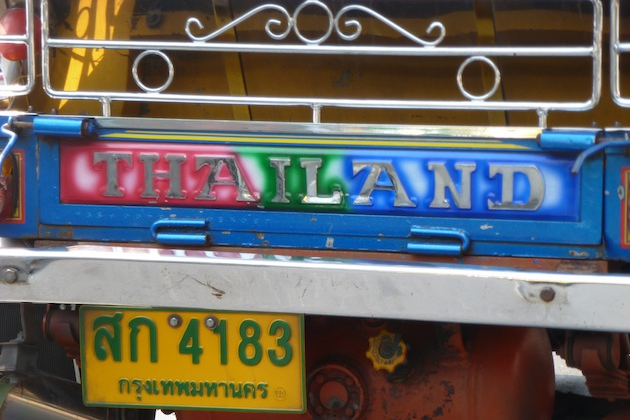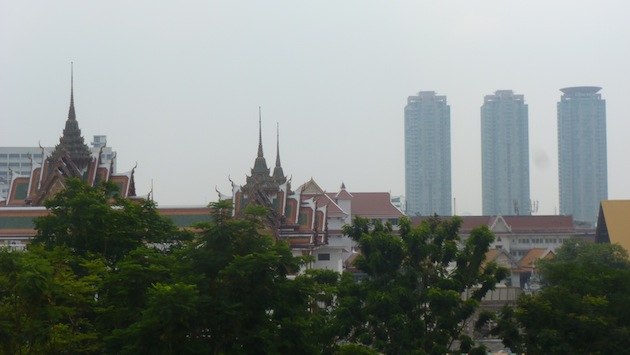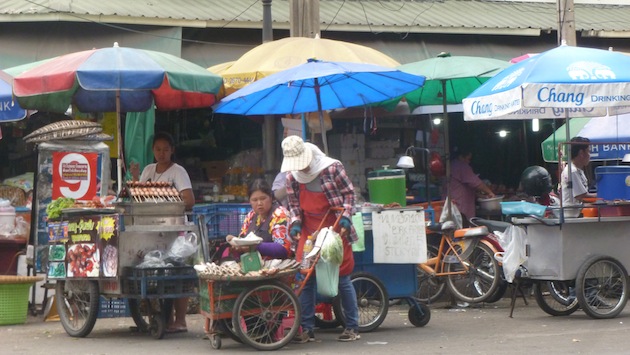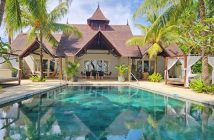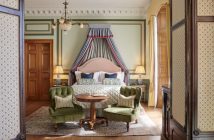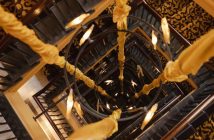In the concluding part of his tour across Thailand, Larry leaves the remote north of the country, landing back into civilisation with a bang…
Thailand is on the march. From China’s example, the focus of the world’s attention, and economy, has been turning east. And it’s evident from the ripple effect of the growth of towns that an indication of this is their reach outward. Chiang Mai, the former walled medieval town, now with its own international airport, and Chiang Rai, similarly, a town closest to the edge of Indochina – as we drove through, seemingly permanently under construction – unsurprisingly, then, that it might also have an airport serving a broader Asian network. But there is one city that is, arguably, the entry and exit point to the country, the place the inhabitants call Krung Thep.
In a matter of an hour, from the fringes of the country to the gargantuan Suvarnabhami airport, we had experienced Thailand’s extremes, trading one jungle for another. As the taxi swept me along the expressway in the centre of the city, I was already looking at something as built up as Manhattan, glittering signs atop skyscrapers told me that every global brand had here, too, made its mark. And descending off the freeway – I say descending, for we were elevated – as we turned into the throng of the city it felt as if we were entering the bowels of some industrial giant; elevated ‘sky trains’ and walkways continued above us. The pitch night was illuminated by neon strips, and the flashing hoardings of familiar brand names and, already, with street-vendors lining these urban arterials, often mere feet from the pristine elegance of designer shops, I was aware of the juxtaposition of the ultra-modern with the elemental in this culture. There was something it immediately reminded me of, and the jarring opening chords of Vangelis’s soundtrack began to tickle me, for I was in the opening sequence of Bladerunner.
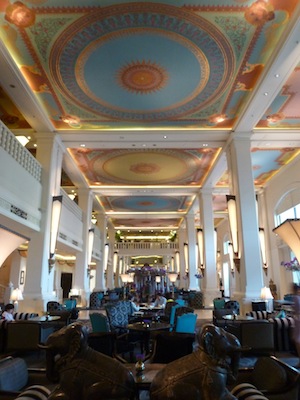 This sudden and dramatic change in environment, from the calm isolation of the Tented Camp, proved an assault on the nerves as much as the senses and it was some relief to be ushered into the calm of my hotel, the Four Seasons, in the city’s downtown district. Lily ponds with nymph-like sculptures bordered the entrance and, as one entered the lobby, with a smile and a Sawasdee-Kaa from the door, a gasp of the air-conditioned lobby from the mugginess outside had an instant calming effect.
This sudden and dramatic change in environment, from the calm isolation of the Tented Camp, proved an assault on the nerves as much as the senses and it was some relief to be ushered into the calm of my hotel, the Four Seasons, in the city’s downtown district. Lily ponds with nymph-like sculptures bordered the entrance and, as one entered the lobby, with a smile and a Sawasdee-Kaa from the door, a gasp of the air-conditioned lobby from the mugginess outside had an instant calming effect.
It was an impressive lobby, too; stately almost, with broad marble staircase ahead, featuring a massive ornate mural depicting a royal coronation on the half-landing, and wide, plush lounges reaching out each side but, worth a visit alone, the undoubted highlight was to walk in and simply look up, where each ceiling section was rendered with the most beautifully hand-painted silk mandalas. I was too late to do anything that evening and it having been the last flight out of Chiang Rai, and the effects of my dawn rendezvous with an elephant were starting to wear, I turned in.
Three things define Krung Thep; temples, tuk-tuks and traffic. Well, significantly more, really, but I liked the alliteration. Although, arguably, you could say that about any major town in Thailand. 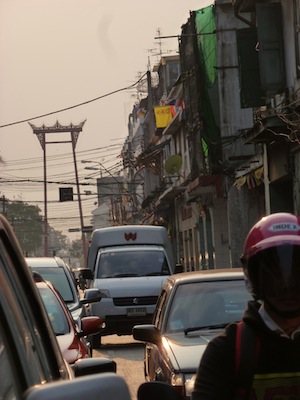 In an attempt to orientate and acclimatise myself, I decided to walk the city. The Four Seasons is a stone’s throw from Rama I, the main thoroughfare with a direct line into the city centre and, on the map, it only looked about 3km; a gentle stroll into town seemed just the ticket.
In an attempt to orientate and acclimatise myself, I decided to walk the city. The Four Seasons is a stone’s throw from Rama I, the main thoroughfare with a direct line into the city centre and, on the map, it only looked about 3km; a gentle stroll into town seemed just the ticket.
This was foolhardy from the outset, being led up and down the skywalk and then, past the main buildings of the downtown area I was in, it just became a trunk road. Think of entering central London by walking on the A40. Thais looked at me as if I was mad, and dozens of smiling tourists flashed past me in tuk-tuks. My decision to walk might still have been acceptable were the traffic to stick to the roads; half the time I was dodging scooters and motorbikes on the pavement. An hour later, dusty, aching and baking, I finally crossed a tributary to the Chao Phraya river and was in Pom Prab, the old town. Though with no idea what to do next.
I had on me a map from the hotel and a 10-year old guide book, from my last visit to the country. Dated in terms of bars and restaurants, its listings of the tourist spots were still relevant, though I refrained from consulting them. I knew I’d seen the Grand Palace previously and some of the more popular destinations, but I was keen to go off the beaten path – hence the lunacy of setting off on foot, for one. Checking the map, I noticed I was near the Golden Mount; that seemed like a sensible starting point and, indeed, involving a climb, would give me a view of the city. It transpired my guide book suggested the same thing. We being in agreement, I made my way to it.
It seemed a low-key tourist spot, which was both fortunate and mildly disappointing. A breezy walk up the mount through trees and shrubbery from the stultifying roadside hike I’d just undertaken – even better, there was aircon inside – but, bar an opportunity to chime a few bells en route and pay respects at the shrines inside it was as views go, simply, a city. A huge, dirty concrete sprawl stretching into the haze, punctuated with high-rises and the odd sala rooftop. One could make out the various landmarks for orientation, certainly, but, ironically, no sooner was I up and out of the beating heart of the action, than I wanted to be back down there, battling through the claustrophobia of the markets and in the midst of the the muggy, fume-choaked miasma below.

